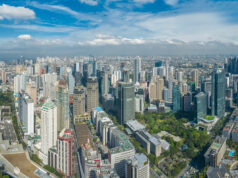MWSS says no imminent water shortage
THE Metropolitan Waterworks and Sewerage System (MWSS) has downplayed fears of a water shortage expressed by a water concession holder, saying that no shortage is imminent.
In a statement on Friday, MWSS Administrator Reynaldo V. Velasco said the supply of potable water is expected to be adequate over the remainder of President Rodrigo R. Duterte’s term, which ends in 2022.
“There is no looming water shortage,” he said.
Mr. Velasco was reacting to the fears raised by Manila Water Co., Inc. that the water from Angat dam for Metro Manila’s east zone, which amounts to 1,600 million liters per day (MLD), is inadequate to meet current demand of 1,650 MLD.
Geodino V. Carpio, Manila Water chief operating officer, told reporters on Wednesday that the company is filling the existing deficiency with supply from La Mesa dam, which he said was not meant for impounding water for distribution.
Mr. Carpio said Manila Water’s new water system in Cardona, Rizal province will add 100 MLD by year end, but it is sufficient to meet the increase in demand over the next two years, or until 2021 if “stretched.”
A proposed project in Laguna de Bay that can supply 250 MLD is up for MWSS approval. It can meet demand until 2023, when the Kaliwa dam in Quezon province is targeted for completion.
Mr. Velasco said under the curent government’s term, MWSS is in “catch-up mode in terms of creating new water sources following more than 30 years of not developing major water supply projects to address the growing demand in Metro Manila due to population growth and development.”
The government has yet to obtain financing for Kaliwa dam, which is expected to provide 650 MLD, of which about half will be allocated to Manila Water.
Under the previous government, the dam was envisioned as a public-private partnership, for which two parties had been pre-qualified. In 2016, the funding source was changed to official development assistance (ODA), with China providing the financing.
“While we respect the opinion of Mr. Carpio, it is best for Manila Water to properly present its P15-billion Laguna East Bay Project that can produce an additional 250 [MLD] water as part of the overall water security and sustainability program for the East Zone instead of making his personal analysis on the overall costing of the Kaliwa Dam Project that is expected to produce an additional 650 [MLD],” Mr. Velasco said.
For consumers, he said the cost of the P13.07-billion Laguna Lake project is expected to be P52 per cubic meter, and P73 per cubic meter for the Kaliwa dam.
The agency said Kaliwa dam is set to go forward once the MWSS board of trustees gives its approval to the winning bidder as recommended by its bids and awards committee.
MWSS has continued several water infrastructure projects started by the past administration to ensure water security: the Bulacan bulk water supply project and the Angat water security project, which is aimed at strengthening the dam to allow it to withstand a 7.2-magnitude earthquake.
MWSS said that in a meeting with Manila Water President and Chief Executive Officer Ferdinand M. de la Cruz and Mr. Carpio, the MWSS chief had been told that the cost of the Laguna Lake project had been reduced to P13.5 billion from P15 billion.
“We welcome any new water source projects such as as the Laguna Lake East Bay but the MWSS position is always to strike a balance between the overall cause and effect on any business development and the interest of the consuming public who will eventually shoulder the expected increase in water rates,” Mr. Velasco said.
He said that in the long run, it would be cheaper to construct new dams than maintain and operate water quality facilities to treat water from Laguna de Bay, which is turbid. — Victor V. Saulon



